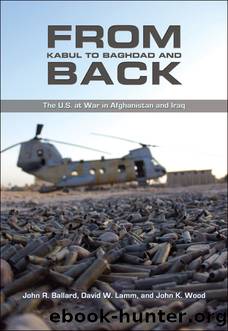From Kabul to Baghdad and Back by John R Ballard

Author:John R Ballard [Ballard, John R.; Lamm, David W.; Wood, John K.]
Language: eng
Format: epub
ISBN: 9781612511689
Publisher: Naval Institute Press
1.Increase the size and capability of the Afghan National Security Forces
2.Strengthen the NATO forces
3.Help President Karzai improve provincial governance and develop the rural economy (with particular emphasis on PRTs)
4.Reverse the increases in opium poppy cultivation
5.Fight corruption.
These five goals were not new or different from the long-standing U.S. strategy for Afghanistan. Since 2002 the United States had set out a comprehensive plan that amounted to nation building and focused on three main pillars: security, governance, and economic development. Also, the five goals outlined by Bush were consistent with the pillars established in Barnoâs campaign plan of 2003, which emphasized building the ANSF, improving reconstruction and good governance, and engaging the regional players
Bushâs speech was consistent with the 2003 CFC-A campaign plan, not some significant, or even nuanced, improvement. The president declared, âThere has to be political development, and tangible evidence that a government can provide opportunity and hope,â but he provided no indication of any political strategy other than continued strong support for President Karzai and the important reconstruction work done by the PRTs. He declared the U.S. strategy as ârobust and importantâ and then went on to announce that he had requested Congress to appropriate an additional $11.8 billion over two years to fund the strategy and that he had extended the tours of 3,200 U.S. troops in country.41 He also explicitly linked administration support to President Musharraf and Pakistan as an important component of the Afghanistan strategy, but without providing any specifics on how cooperation with the Pakistanis would or should play out. The strategies for both Iraq and Afghanistan both had elements of nation buildingâthe endeavor the Bush team had explicitly spurned in the 2000 presidential campaign and the early months of the administration. The president had recognized that to secure Afghanistan against a return of the Taliban and keep it from becoming a safe haven for Al-Qaeda some degree of nation building was required.
The same day as the presidentâs speech the White House released a fact sheet stating that the âclear goalâ of the United States was to âhelp the people of Afghanistan defeat the terrorists, and establish a stable, moderate, and democratic state that respects the rights of its citizens, governs its territory effectively, and is a reliable ally in the War on Terror.â The second stated purpose added an unequivocal charge to conduct nation building: âto help President Karzai defeat our common enemies and help the Afghan people build a free and successful nation.â42
Not surprisingly, nowhere in the presidentâs speech or the fact sheet was any indication as to whether the increased funding and the marginal extension of the 3,200 soldiers were what the commander and the ambassador actually needed or had requested in order to accomplish the mission. And there was no indication that the president had concluded that he needed to improve execution within his cabinet and NSC staff.
Congress was still paying attention, at least the House Armed Services Committee. In June a small interagency team went to the Hill to give a closed briefing to the HASC.
Download
This site does not store any files on its server. We only index and link to content provided by other sites. Please contact the content providers to delete copyright contents if any and email us, we'll remove relevant links or contents immediately.
The Radium Girls by Kate Moore(11935)
100 Deadly Skills by Clint Emerson(4845)
Rise and Kill First by Ronen Bergman(4706)
The Templars by Dan Jones(4630)
The Doomsday Machine by Daniel Ellsberg(4421)
The Rape of Nanking by Iris Chang(4142)
Killing England by Bill O'Reilly(3953)
Hitler in Los Angeles by Steven J. Ross(3902)
Stalin by Stephen Kotkin(3885)
12 Strong by Doug Stanton(3511)
Hitler's Monsters by Eric Kurlander(3270)
Blood and Sand by Alex Von Tunzelmann(3140)
The Code Book by Simon Singh(3079)
Darkest Hour by Anthony McCarten(3072)
The Art of War Visualized by Jessica Hagy(2945)
Hitler's Flying Saucers: A Guide to German Flying Discs of the Second World War by Stevens Henry(2716)
Babylon's Ark by Lawrence Anthony(2622)
The Second World Wars by Victor Davis Hanson(2486)
Tobruk by Peter Fitzsimons(2449)
